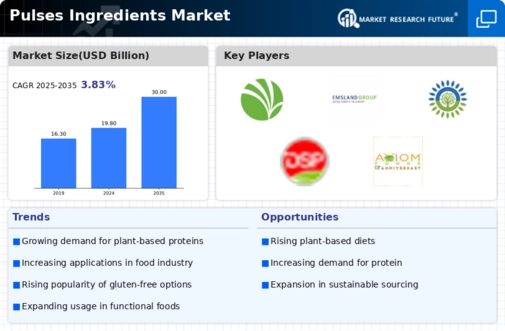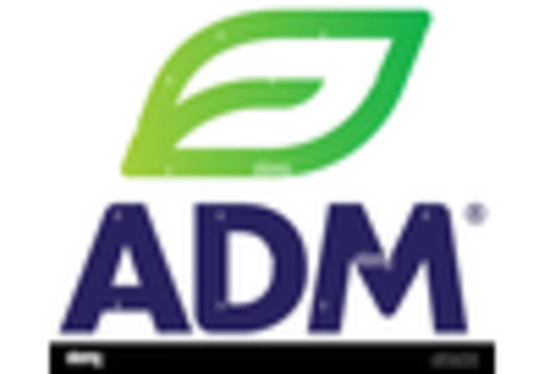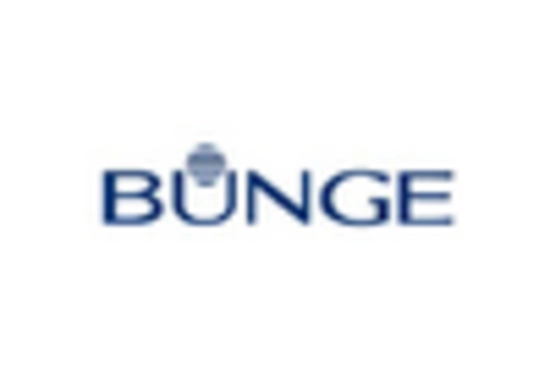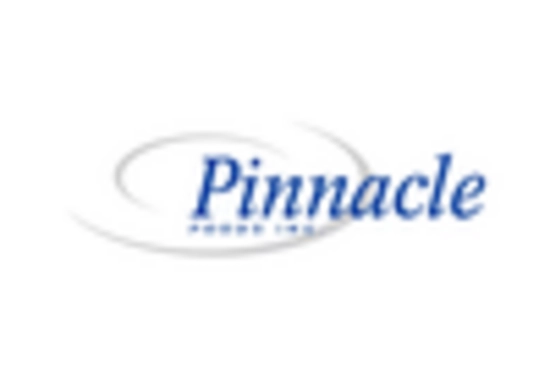-
Executive Summary
-
Scope of the Report
-
Market Definition
-
Scope of the Study
- Research Objectives
- Assumptions & Limitations
-
Market Structure
-
Market Research Methodology
-
Research Process
-
Secondary Research
-
Primary Research
-
Forecast Model
-
Market Landscape
-
Supply Chain Analysis
- Source Suppliers
- Manufacturers/Producers
- Distributors/Retailers/Wholesalers/E-Commerce
- End Users
-
Porter’s Five Forces Analysis
- Threat of New Entrants
- Bargaining Power of Buyers
- Bargaining Power of Suppliers
- Threat of Substitutes
- Internal Rivalry
-
Market Dynamics of Global Pulses Ingredients Market
-
Introduction
-
Drivers
-
Restraints
-
Opportunities
-
Challenges
-
Global Pulses Ingredients Market, by Type
-
Introduction
-
Pulse Flours
- Market Estimates & Forecast, 2023–2032
- Market Estimates & Forecast, by Region, 2023–2032
-
Pulse Starch
- Market Estimates & Forecast, 2023–2032
- Market Estimates & Forecast, by Region, 2023–2032
-
Pulse Proteins
- Market Estimates & Forecast, 2023–2032
- Market Estimates & Forecast, by Region, 2023–2032
-
Others
- Market Estimates & Forecast, 2023–2032
- Market Estimates & Forecast, by Region, 2023–2032
-
Global Pulses Ingredients Market, by Source
-
Introduction
-
Lentils
- Market Estimates & Forecast, 2023–2032
- Market Estimates & Forecast, by Region, 2023–2032
-
Peas
- Market Estimates & Forecast, 2023–2032
- Market Estimates & Forecast, by Region, 2023–2032
-
Beans
- Market Estimates & Forecast, 2023–2032
- Market Estimates & Forecast, by Region, 2023–2032
-
Chickpeas
- Market Estimates & Forecast, 2023–2032
- Market Estimates & Forecast, by Region, 2023–2032
-
Others
- Market Estimates & Forecast, 2023–2032
- Market Estimates & Forecast, by Region, 2023–2032
-
Global Pulses Ingredients Market, by Application
-
Introduction
-
Food & Beverage
- Market Estimates & Forecast, 2023–2032
- Market Estimates & Forecast, by Region, 2023–2032
- Bakery & Confectionery
- Sauces, Dressings, and Spreads
- RTE & RTC Foods
- Others
-
Animal Feed
- Market Estimates & Forecast, 2023–2032
- Market Estimates & Forecast, by Region, 2023–2032
-
Others
- Market Estimates & Forecast, 2023–2032
- Market Estimates & Forecast, by Region, 2023–2032
-
Global Pulses Ingredients Market, by Region
-
Introduction
-
North America
- Market Estimates & Forecast, 2023–2032
- Market Estimates & Forecast, by Type, 2023–2032
- Market Estimates & Forecast, by Source, 2023–2032
- Market Estimates & Forecast, by Application, 2023–2032
- US
- Canada
- Mexico
-
Europe
- Market Estimates & Forecast, 2023–2032
- Market Estimates & Forecast, by Type, 2023–2032
- Market Estimates & Forecast, by Source, 2023–2032
- Market Estimates & Forecast, by Application, 2023–2032
- Germany
- France
- Italy
- Spain
- Rest of Europe
-
Asia-Pacific
- Market Estimates & Forecast, 2023–2032
- Market Estimates & Forecast, by Type, 2023–2032
- Market Estimates & Forecast, by Source, 2023–2032
- Market Estimates & Forecast, by Application, 2023–2032
- China
- India
- Japan
- Australia & New Zealand
- Rest of Asia-Pacific
-
Rest of the World (RoW)
- Market Estimates & Forecast, 2023–2032
- Market Estimates & Forecast, by Type, 2023–2032
- Market Estimates & Forecast, by Source, 2023–2032
- Market Estimates & Forecast, by Application, 2023–2032
- South America
- Middle East
- Africa
-
Company Landscape
-
Introduction
-
Market Strategy
-
Key Development Analysis
-
(Expansions/Mergers and Acquisitions/Joint Ventures/New Product Developments/Agreements/Investments
-
Company Profiles
-
Ingredion Incorporated
- Company Overview
- Financial Updates
- Product/Business Segment Overview
- Strategy
- Key Developments
- SWOT Analysis
-
Roquette Frères
- Company Overview
- Financial Updates
- Product/Business Segment Overview
- Strategy
- Key Developments
- SWOT Analysis
-
Emsland Group
- Company Overview
- Financial Updates
- Product/Business Segment Overview
- Strategy
- Key Developments
- SWOT Analysis
-
The Scoular Company
- Company Overview
- Financial Updates
- Product/Business Segment Overview
- Strategy
- Key Developments
- SWOT Analysis
-
Archer Daniels Midland Company
- Company Overview
- Financial Updates
- Product/Business Segment Overview
- Strategy
- Key Developments
- SWOT Analysis
-
SunOpta Inc.
- Company Overview
- Financial Updates
- Product/Business Segment Overview
- Strategy
- Key Developments
- SWOT Analysis
-
Diefenbaker Spice & Pulse
- Company Overview
- Financial Updates
- Product/Business Segment Overview
- Strategy
- Key Developments
- SWOT Analysis
-
Axiom Foods Inc.
- Company Overview
- Financial Updates
- Product/Business Segment Overview
- Strategy
- Key Developments
- SWOT Analysis
-
Cosucra Groupe Warcoing SA
- Company Overview
- Financial Updates
- Product/Business Segment Overview
- Strategy
- Key Developments
- SWOT Analysis
-
Dakota Dry Bean
- Company Overview
- Financial Updates
- Product/Business Segment Overview
- Strategy
- Key Developments
- SWOT Analysis
-
Conclusion
-
-
LIST OF TABLES
-
Global Pulses Ingredients Market, by Region, 2023–2032 (USD Million)
-
Global Pulses Ingredients Market, by Type, 2023–2032 (USD Million)
-
Global Pulses Ingredients Market, by Source, 2023–2032 (USD Million)
-
Global Pulses Ingredients Market, by Application, 2023–2032 (USD Million)
-
North America: Pulses Ingredients Market, by Country, 2023–2032 (USD Million)
-
North America: Pulses Ingredients Market, by Type, 2023–2032 (USD Million)
-
North America: Pulses Ingredients Market, by Source, 2023–2032 (USD Million)
-
North America: Pulses Ingredients Market, by Application, 2023–2032 (USD Million)
-
US: Pulses Ingredients Market, by Type, 2023–2032 (USD Million)
-
US: Pulses Ingredients Market, by Source, 2023–2032 (USD Million)
-
US: Pulses Ingredients Market, by Application, 2023–2032 (USD Million)
-
Canada: Pulses Ingredients Market, by Type, 2023–2032 (USD Million)
-
Canada: Pulses Ingredients Market, by Source, 2023–2032 (USD Million)
-
Canada: Pulses Ingredients Market, by Application, 2023–2032 (USD Million)
-
Mexico: Pulses Ingredients Market, by Type, 2023–2032 (USD Million)
-
Mexico: Pulses Ingredients Market, by Source, 2023–2032 (USD Million)
-
Mexico: Pulses Ingredients Market, by Application, 2023–2032 (USD Million)
-
Europe: Pulses Ingredients Market, by Country, 2023–2032 (USD Million)
-
Europe: Pulses Ingredients Market, by Type, 2023–2032 (USD Million)
-
Europe: Pulses Ingredients Market, by Source, 2023–2032 (USD Million)
-
Europe: Pulses Ingredients Market, by Application, 2023–2032 (USD Million)
-
Germany: Pulses Ingredients Market, by Type, 2023–2032 (USD Million)
-
Germany: Pulses Ingredients Market, by Source, 2023–2032 (USD Million)
-
Germany: Pulses Ingredients Market, by Application, 2023–2032 (USD Million)
-
France: Pulses Ingredients Market, by Type, 2023–2032 (USD Million)
-
France: Pulses Ingredients Market, by Source, 2023–2032 (USD Million)
-
France: Pulses Ingredients Market, by Application, 2023–2032 (USD Million)
-
Italy: Pulses Ingredients Market, by Type, 2023–2032 (USD Million)
-
Italy: Pulses Ingredients Market, by Source, 2023–2032 (USD Million)
-
Italy: Pulses Ingredients Market, by Application, 2023–2032 (USD Million)
-
Spain: Pulses Ingredients Market, by Type, 2023–2032 (USD Million)
-
Spain: Pulses Ingredients Market, by Source, 2023–2032 (USD Million)
-
Spain: Pulses Ingredients Market, by Application, 2023–2032 (USD Million)
-
UK: Pulses Ingredients Market, by Type, 2023–2032 (USD Million)
-
UK: Pulses Ingredients Market, by Source, 2023–2032 (USD Million)
-
UK: Pulses Ingredients Market, by Application, 2023–2032 (USD Million)
-
Rest of Europe: Pulses Ingredients Market, by Type, 2023–2032 (USD Million)
-
Rest of Europe: Pulses Ingredients Market, by Source, 2023–2032 (USD Million)
-
Rest of Europe: Pulses Ingredients Market, by Application, 2023–2032 (USD Million)
-
Asia-Pacific: Pulses Ingredients Market, by Country, 2023–2032 (USD Million)
-
Asia-Pacific: Pulses Ingredients Market, by Type, 2023–2032 (USD Million)
-
Asia-Pacific: Pulses Ingredients Market, by Source, 2023–2032 (USD Million)
-
Asia-Pacific: Pulses Ingredients Market, by Application, 2023–2032 (USD Million)
-
China: Pulses Ingredients Market, by Type, 2023–2032 (USD Million)
-
China: Pulses Ingredients Market, by Source, 2023–2032 (USD Million)
-
China: Pulses Ingredients Market, by Application, 2023–2032 (USD Million)
-
India: Pulses Ingredients Market, by Type, 2023–2032 (USD Million)
-
India: Pulses Ingredients Market, by Source, 2023–2032 (USD Million)
-
India: Pulses Ingredients Market, by Application, 2023–2032 (USD Million)
-
Japan: Pulses Ingredients Market, by Type, 2023–2032 (USD Million)
-
Japan: Pulses Ingredients Market, by Source, 2023–2032 (USD Million)
-
Japan: Pulses Ingredients Market, by Application, 2023–2032 (USD Million)
-
Rest of Asia-Pacific: Pulses Ingredients Market, by Type, 2023–2032 (USD Million)
-
Rest of Asia-Pacific: Pulses Ingredients Market, by Source, 2023–2032 (USD Million)
-
Rest of Asia-Pacific: Pulses Ingredients Market, by Application, 2023–2032 (USD Million)
-
Rest of the World (RoW): Pulses Ingredients Market, by Country, 2023–2032 (USD Million)
-
Rest of the World (RoW): Pulses Ingredients Market, by Type, 2023–2032 (USD Million)
-
Rest of the World (RoW): Pulses Ingredients Market, by Source, 2023–2032 (USD Million)
-
Rest of the World (RoW): Pulses Ingredients Market, by Application, 2023–2032 (USD Million)
-
South America: Pulses Ingredients Market, by Type, 2023–2032 (USD Million)
-
South America: Pulses Ingredients Market, by Source, 2023–2032 (USD Million)
-
South America: Pulses Ingredients Market, by Application, 2023–2032 (USD Million)
-
Middle East: Pulses Ingredients Market, by Type, 2023–2032 (USD Million)
-
Middle East: Pulses Ingredients Market, by Source, 2023–2032 (USD Million)
-
Middle East: Pulses Ingredients Market, by Application, 2023–2032 (USD Million)
-
Africa: Pulses Ingredients Market, by Type, 2023–2032 (USD Million)
-
Africa: Pulses Ingredients Market, by Source, 2023–2032 (USD Million)
-
Africa: Pulses Ingredients Market, by Application, 2023–2032 (USD Million)
-
LIST OF FIGURES
-
Global Pulses Ingredients Market Segmentation
-
Forecast Research Methodology
-
Five Forces Analysis of the Global Pulses Ingredients Market
-
Value Chain of the Global Pulses Ingredients Market
-
Share of the Global Pulses Ingredients Market in 2023, by Country (%)
-
Global Pulses Ingredients Market, by Region, 2023–2032,
-
Global Pulses Ingredients Market Size, by Type, 2023
-
Share of Global Pulses Ingredients Market, by Type, 2023–2032 (%)
-
Global Pulses Ingredients Market Size, by Source, 2023
-
Share of Global Pulses Ingredients Market, by Source, 2023–2032 (%)
-
Global Pulses Ingredients Market Size, by Application, 2023
-
Share of Global Pulses Ingredients Market, by Application, 2023–2032 (%)'









Leave a Comment